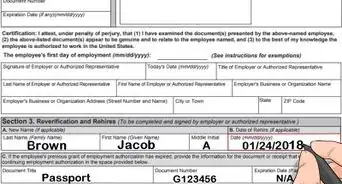This article was co-authored by Clinton M. Sandvick, JD, PhD. Clinton M. Sandvick worked as a civil litigator in California for over 7 years. He received his JD from the University of Wisconsin-Madison in 1998 and his PhD in American History from the University of Oregon in 2013.
There are 14 references cited in this article, which can be found at the bottom of the page.
This article has been viewed 51,311 times.
Harassment comes in many forms and involves more than touching or making “quid pro quo” offers where continued employment is offered in exchange for sexual favors. Under federal law, harassment includes the creation of a hostile work environment. A workplace becomes “hostile” when harassment based on a protected characteristic is so pervasive that it is abusive. To prove that your work environment is hostile, you will need to gather sufficient evidence of the offensive conduct and report it to a governmental agency.
Steps
Understanding Hostile Work Environments
-
1Understand the federal definition of “hostile work environment.” Under Title VII of the Civil Rights Act of 1964 and other federal laws, harassment is unwelcome conduct based on race, color, religion, sex (including pregnancy), national origin, age (40 or older), disability, or genetic information. Unwelcome conduct becomes unlawful harassment when enduring the conduct becomes a condition of employment. It also is unlawful when it is so pervasive that the work environment becomes intimidating, abusive, and hostile.[1]
- The test for whether a work environment is “hostile” is whether it would be intimidating, hostile, or offensive to reasonable people. Petty slights and annoyances would not qualify. Nor would most isolated incidents of unwelcome conduct.[2]
- Offensive conduct includes slurs, epithets, offensive jokes, physical assaults, threats, intimidation, ridicule, mockery, put-downs, insults, offensive pictures or objects.[3] The offensive conduct must be based on a protected characteristic (such as race, gender, etc.) to violate federal law.[4] The conduct must be so severe, reoccurring, or pervasive that it interferes with the employee’s ability to do their job.
-
2Check if your employer is covered. Federal anti-discrimination laws do not apply to all employers in the United States. Instead, an employer must have 15 or more employees (or 20 employees if alleging age discrimination).[5]Advertisement
-
3Research state law. If your employer is not covered by federal law, then it may be covered by an equivalent state law. Many states have anti-discrimination laws to cover employees not captured by the federal law. Furthermore, some state laws provide greater protection by prohibiting discrimination on the grounds of sexual orientation.
- To find state law, you can search in your local courthouse law library or on the Internet. To search the Internet, type your state and “antidiscrimination” or “hostile workplace” into your web browser.
-
4Recognize examples of a hostile work environment. A work environment may become intimidating, abusive, and hostile in a variety of ways. The harasser does not have to be the supervisor. Instead, harassers can also be co-worker, subordinates, or non-employees. Nor does the person complaining about the hostile work environment have to be the object of the harassment.
- A woman was awarded $8 million for egregious tormenting because she was a woman. She was trapped in a port-a-potty for 20 minutes on a hot day, regularly shown pictures of naked women, and ridiculed for working in a male-dominated industry.
- A waitress prevailed on a hostile workplace claim when two customers came into her restaurant and made filthy comments. On one occasion, one of the customers pulled her hair and then placed his mouth on her breast.[6]
-
5Meet with a lawyer. To understand whether or not you have a legitimate hostile workplace claim, you should probably meet with a lawyer. A lawyer can help you identify whether the harassment rises to illegal conduct. To find a lawyer, contact your state’s bar association. It should run a referral service.
- You might want to meet with a lawyer who is a certified specialist in employment law. Not every state allows certification. But some states will certify specialists if they have dedicated a certain percentage of their practice to employment law. Applicants also must take advanced legal education classes and receive recommendations from other lawyers or judges. Lastly, applicants must pass a written exam to earn the certification.
- Employment litigation can be expensive. Usually, an employment case will cost between $8,000 and $30,000 in attorney’s fees.[7] You can discuss alternate fee arrangements when you meet with the lawyer for a consultation.
- Usually, lawyers bill on an hourly basis. However, many employment attorneys will represent clients on a “contingency” fee agreement. Under this arrangement, the lawyer gets paid a percentage of your award amount only if you win the case. Although you might still be responsible for paying court costs, such as filing fees and court reporters, a contingency fee agreement can make legal representation affordable.[8]
Gathering Evidence
-
1Preserve all communications. If emails, memos, letters, or voicemails contain harassing language, then you should make sure to preserve all of them. This evidence will be critical for proving a hostile work environment.
- The communications do not need to have been made only in the workplace. If a co-worker or boss contacts you at home, then these communications are also relevant.[9]
- Also preserve any communication where you inform a supervisor or Human Resources about the harassment. You will strengthen your case if you can show that you put your employer on notice about the harassment. A jury might view an employer who does not swiftly stamp out harassment as being complicit in the conduct. This helps show that the harassment is pervasive, as it seems to be approved by top management.
-
2Document conversations and other harassment. If you are teased, harassed, or verbally abused, then you should write down important information about the incidents. The notes you take might be the only evidence that exists of these face-to-face taunts.
-
3Identify witnesses. You can strengthen your case if you have third parties who witnessed the harassment. Write down their names and the incidents that they observed. If they no longer work for the same employer, then try to get their contact information.
- Share the witness information with your attorney. Your attorney will contact them and confirm that they are willing to testify. If they are unwilling, then your lawyer may have to subpoena the witnesses.
-
4Save performance reviews. Once you show offensive conduct, you will then need to show that you were impacted by it. For example, your job performance may have slipped as the harassment increased. You should preserve copies of your performance reviews if they show the steadily slipping performance once the harassment started.
- Also save other evidence that shows the impact the harassment has had on you. You should keep all medical and psychiatric records that document the effect of the stress. You do not need to have a nervous breakdown before suing for a hostile work environment.[10] However, proof of a negative physical or mental impact will certainly bolster your case.
Reporting to Administrative Agencies
-
1Determine which agency you will report to. Federal antidiscrimination law applies to those employers who employ 15 or more employees (20 or more employees for age discrimination claims). If your employer is covered, then you can report a hostile work environment to the federal Equal Employment Opportunity Commission (EEOC).[11]
- If your employer is not covered by federal law, then you may report to your state’s equivalent agency. If your employer is covered by both state and federal laws, then you can choose which agency to file your charge with. If your state's laws are more protective of employees than federal law, consider filing with your state agency. For example, California has more stringent workplace protections than federal law requires. If you live in California, you should consider filing a report with the California Department of Fair Employment and Housing.
- You should use the EEOC’s assessment tool to figure out which agency to file with.
-
2File a charge with the EEOC. If you choose to report to the EEOC, then you can file a charge with any of its field offices. On the EEOC website there is a map of the 53 field offices around the country. You should contact the office nearest you. Some offices require appointments while others accept walk-ins. Call ahead of time and ask.
- Don’t wait to file. Generally, you have 180 days to file a charge with the EEOC. The deadline is extended if your state law provides a longer deadline. However, you shouldn’t wait too long.[12]
-
3Write a letter to the EEOC. If the nearest field office is too far away for you to visit, then you can file a charge by writing a letter. Make sure that the letter includes the following information:[13]
- your name, address, and telephone number
- your employer’s name, address, and telephone number
- the number of employees employed there
- a short description of the events you believe were discriminatory
- when the events took place
- that a protected characteristic was the motivation for the discriminatory events
- your signature
-
4File a charge with your state administrative agency. The exact process will vary from state to state. For example, in California, you must first file a “pre-complaint inquiry.” There are four different ways to do so:[14]
- Call 800-884-1684 (or 800-884-1684 if deaf or hard of hearing).
- Fill out and mail the Inquiry form to any Department of Fair Employment and Housing Office.
- Email a completed Inquiry form to contact.center@dfeh.ca.gov.
Suing for Harassment
-
1File a lawsuit. You can start your lawsuit by filing a complaint in the appropriate court. If you have a lawyer, they will draft it for you. The complaint alleges facts surrounding the work environment and asks the court for relief (such as lost wages or reinstatement in a job).
- Generally, you will file in federal district court if you are suing under federal antidiscrimination law. If you are suing under your state’s antidiscrimination law, then you will file in a state court.
- In order to bring suit, you need a “Notice of Right-to-Sue” letter from the administrative agency that you filed your initial charge with. The EEOC will issue the letter after conducting its investigation. You have 90 days to file a lawsuit from the date you receive your letter.[15]
- If you want to sue before the EEOC has completed its investigation, then you will need to ask for the Right-to-Sue letter. At least 180 days must have passed since you filed the charge with EEOC. If so, then send a letter to the director of the office investigating your charge. The agency will close the investigation once it issues the letter.[16]
-
2Prove the elements of a hostile workplace claim. What you need to prove will differ slightly depending on the court you are suing in. Generally, to prove a hostile workplace claim you must show that:[17]
- you were harassed because of a protected characteristic
- the harassment was unwelcome
- the harassment was so pervasive or severe as to create an abusive work environment
- there is some basis to impute liability to the employer
-
3Present evidence of harassment. The hardest part of a hostile workplace claim will be proving that the harassment happened “because of” your protected characteristic. In other words, your race, age, gender, religion, etc. must have been the motivation for the harassment.[18] Offensive, vulgar, and abusive statements unrelated to your protected characteristic will not qualify.
- For example, you may have been called a “dwarf” or “half-wit” by a boss. However, if you are claiming gender discrimination, then these comments will not help you as there is no logical connection between them and gender.[19]
- However, misogynist or racial epithets would qualify. On their face, these kinds of comments about a group are offensive and related to the protected characteristic.
- To prove harassment, you will need to introduce relevant evidence that you have gathered: emails, notes, documented conversations. Also, witnesses can testify as to what they heard or saw.
-
4Show that the harassment is pervasive or severe. To prove this element, you need to do more than show that you were personally offended. This kind of “subjective” evidence is necessary but not sufficient. Instead, you must prove that the harassment was so pervasive or severe as to be “objectively” abusive. In other words, it must be abusive to a reasonable person in your position.[20]
- There is no required number of incidents necessary to qualify as pervasive or severe. One episode of abuse can be sufficiently severe to make the environment hostile. For example, a single incident of sexual assault can qualify.[21]
- No single factor is determinative. You can prove this factor by presenting all of the evidence of offensive comments, physical touching, or other abusive behavior.
-
5Impute liability to your employer. You can establish this element by showing that the employer knew or should have known about the harassment and the employer failed to take remedial action. [22]
- Here, your emails or letter to Human Resources reporting the harassment will help you prove this element.
References
- ↑ https://www.fedemploymentlaw.com/eeoc-equal-employment-opportunity-commission/hostile-work-environment/
- ↑ https://www.fedemploymentlaw.com/eeoc-equal-employment-opportunity-commission/hostile-work-environment/
- ↑ https://www.fedemploymentlaw.com/eeoc-equal-employment-opportunity-commission/hostile-work-environment/
- ↑ http://www.nolo.com/legal-encyclopedia/my-boss-yells-me-can-i-sue-hostile-work-environment.html
- ↑ https://www.fedemploymentlaw.com/eeoc-equal-employment-opportunity-commission/hostile-work-environment/
- ↑ Lockard v. Pizza Hut, 162 F.3d 1062 (10th Cir. 1998)
- ↑ http://www.nolo.com/legal-encyclopedia/free-books/employee-rights-book/chapter17-5.html
- ↑ http://www.nolo.com/legal-encyclopedia/free-books/employee-rights-book/chapter17-5.html
- ↑ http://www2.law.ucla.edu/volokh/harass/breadth.htm
- ↑ Lockard v. Pizza Hut, 162 F.3d 1062 (10th Cir. 1998)
- ↑ http://www.eeoc.gov/laws/types/sex.cfm
- ↑ http://www.eeoc.gov/laws/types/sex.cfm
- ↑ http://eeoc.gov/employees/howtofile.cfm
- ↑ https://roadmap.rootandrebound.org/employment/employment-appendix/california-department-of-fair-employment-and-housi/
- ↑ http://www.eeoc.gov/employees/lawsuit.cfm
- ↑ http://www.eeoc.gov/employees/lawsuit.cfm
- ↑ Hartsell v. Duplex Prods., 123 F.3d 766 (4th Cir. 1997)
- ↑ http://www.jgllaw.com/blog/hostile-work-environment-overused-misunderstood#_ftn11
- ↑ Hartsell v. Duplex Prods., 123 F.3d 766 (4th Cir. 1997)
- ↑ http://www.jgllaw.com/blog/hostile-work-environment-overused-misunderstood#_ftn11
- ↑ Quinn v. Green Tree Credit Corp., 159 F.3d 759 (2d Cir. 1998)
- ↑ https://dictionary.law.com/default.aspx?selected=912



























-Status-Step-6.webp)



















































